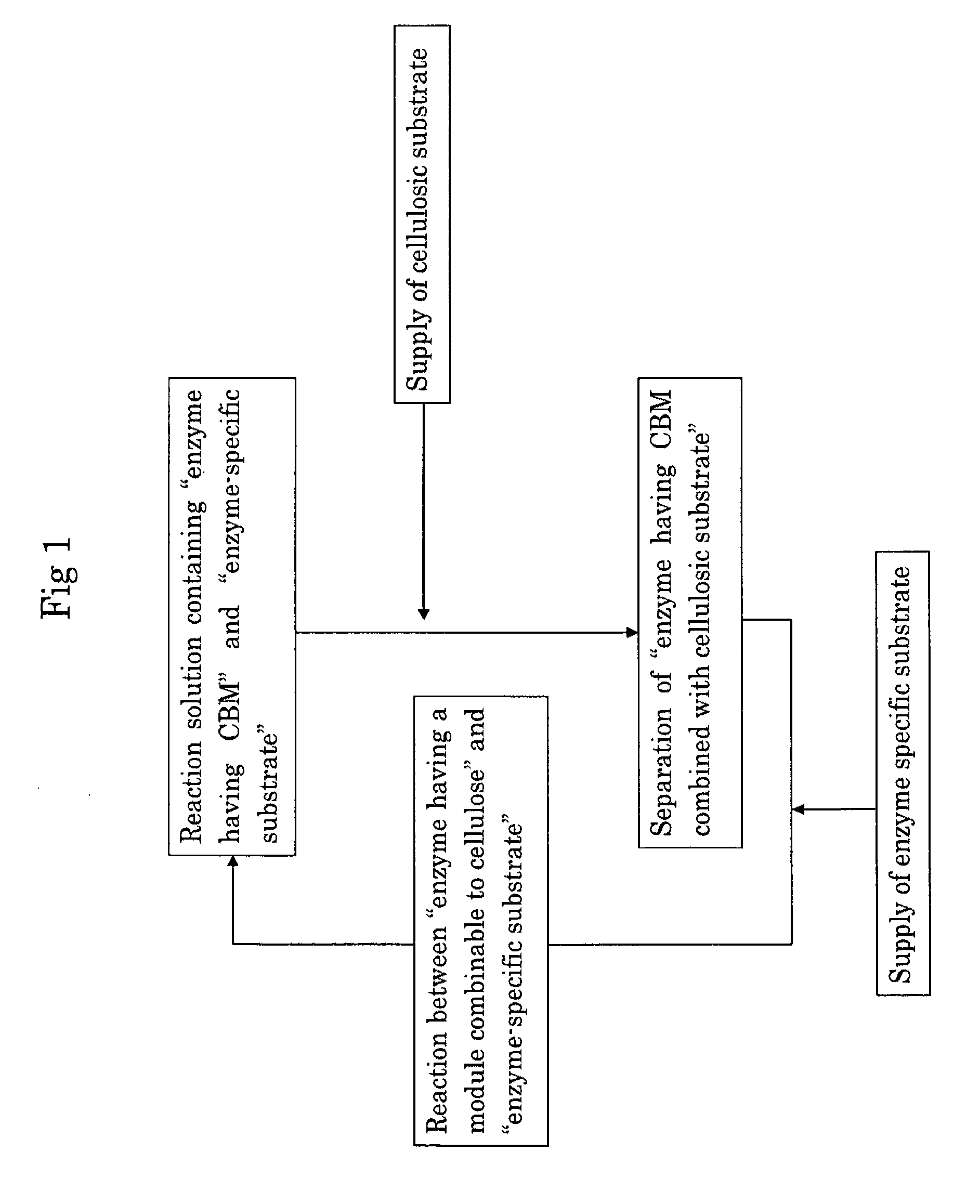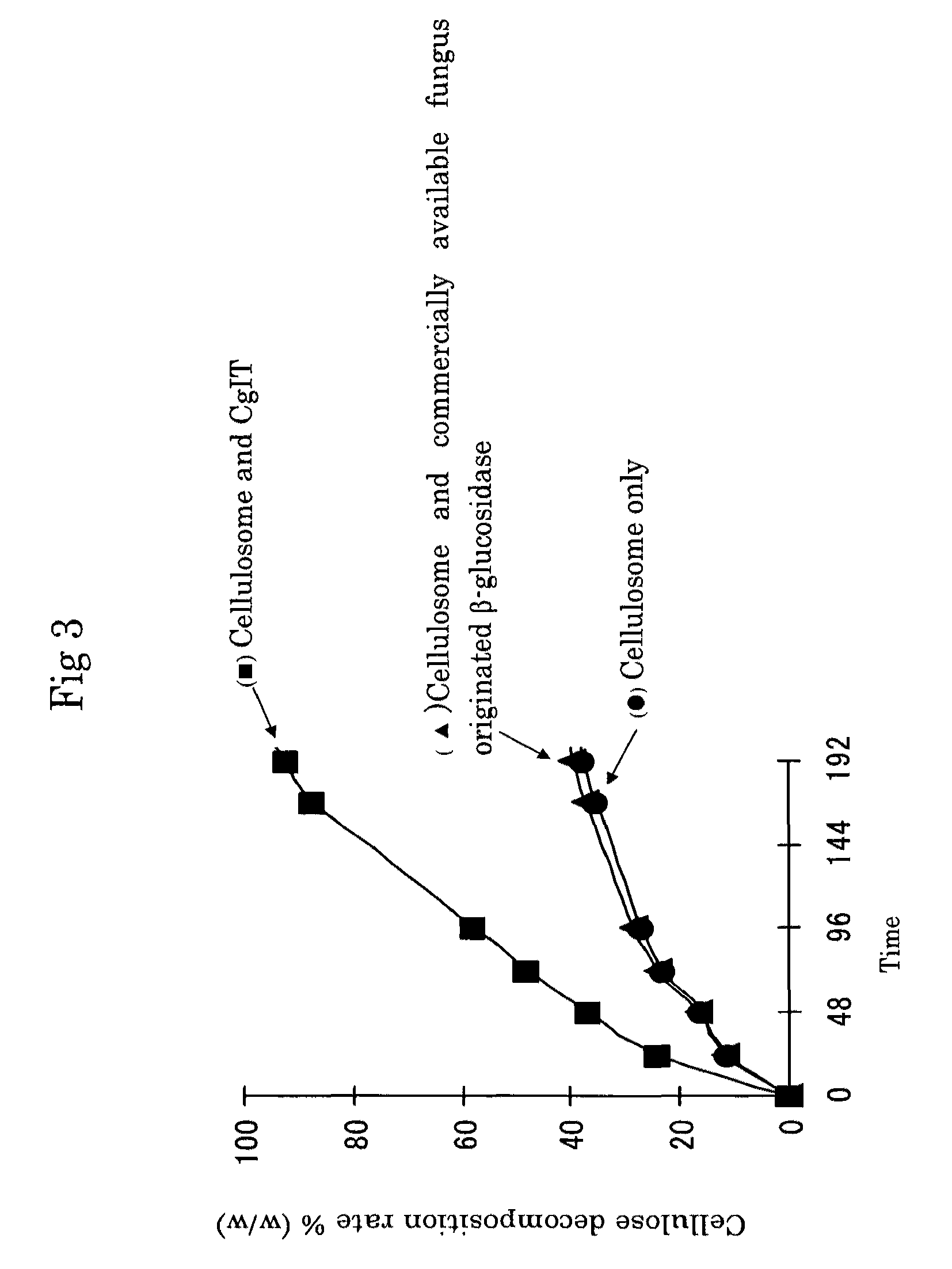Method for recycling enzyme
a technology of enzymes and enzymes, applied in the field of enzyme recovery and reusing, can solve the problems of reducing cost and improving energy conversion efficiency, requiring enormous energy for physical treatment, and preventing specific enzyme activity only, so as to reduce enzyme usage and reduce enzyme usage. , the effect of efficient separation and recovery
- Summary
- Abstract
- Description
- Claims
- Application Information
AI Technical Summary
Benefits of technology
Problems solved by technology
Method used
Image
Examples
embodiment 1
[0037]In embodiment 1 is a method for recycling an enzyme, comprising: combining an enzyme having a module combinable with cellulose and a cellulosic substrate, and using the cellulosic substrate-bound enzyme obtained repeatedly.
[0038]More specifically, as shown in FIG. 1, a cellulosic substrate is added to an enzyme reaction liquid containing an enzyme having a module combinable to cellulose (carbohydrate binding module [CBM]) (hereinafter referred to as the enzyme having CBM) and an enzyme-specific substrate, the CBM is made to combine with the cellulosic substrate, a cellulosic substrate-bound enzyme having CBM is separated from the enzyme reaction liquid, the enzyme-specific substrate is added to the separated cellulosic substrate-bound enzyme having CBM, and the above procedure is repeated to recycle the enzyme.
[0039]In other words, the method for recycle the enzyme having CBM comprises a first step of combining the enzyme having CBM to the cellulosic substrate by adding the ce...
embodiment 2
[0052]In embodiment 2, this method for recycling enzymes uses two enzymes, namely cellulosome and β-glucosidase having CBM. Embodiment 2 differs from Embodiment 1 in that two types of enzymes, namely cellulosome and β-glucosidase having CBM, are specified as the enzymes having CBM.
[0053]It is known that when cellulosic biomass is saccharized by cellulosome, the enzyme activity of cellulosome is inhibited by cellobiose, the final product of the enzyme reaction, and consequently, the cellulosic biomass cannot be decomposed into cellobiose or oligosaccharide efficiently.
[0054]In order to remove cellobiose from the enzyme reaction system in the saccharification reaction of cellulosic biomass using cellulosome, the inventors used β-glucosidase in combination. Cellulose-decomposing efficiency improved at first, but after repetitive use, the cellulose-decomposing efficiency was found to decrease, maybe because β-glucosidase, which is derived from thermophilic and anaerobic bacteria, is los...
embodiment 3
[0070]Embodiment 3 differs from embodiment 2 in that the cellulosic substrate is a cellulosic biomass containing lignin.
[0071]Specifically, the method of this embodiment is characterized in that cellulosic biomass containing lignin is added to an enzyme reaction liquid, which contains cellulosic biomass containing lignin, β-glucosidase having CBM and cellulosome, to allow the β-glucosidase having CBM and cellulosome to combine and react with the cellulosic biomass containing lignin, the β-glucosidase having CBM and cellulosome combined with the cellulosic biomass are separated from the reaction system, and thus the β-glucosidase having CBM and cellulosome combined with the cellulosic biomass are used repetitively.
[0072]In other words, the method of recycling enzymes in this embodiment comprises a first step wherein cellulosic biomass containing lignin is added to an enzyme reaction liquid containing cellulosic biomass, β-glucosidase having CBM, and cellulosome to allow the celluloso...
PUM
| Property | Measurement | Unit |
|---|---|---|
| temperature | aaaaa | aaaaa |
| concentration | aaaaa | aaaaa |
| concentration | aaaaa | aaaaa |
Abstract
Description
Claims
Application Information
 Login to View More
Login to View More - R&D
- Intellectual Property
- Life Sciences
- Materials
- Tech Scout
- Unparalleled Data Quality
- Higher Quality Content
- 60% Fewer Hallucinations
Browse by: Latest US Patents, China's latest patents, Technical Efficacy Thesaurus, Application Domain, Technology Topic, Popular Technical Reports.
© 2025 PatSnap. All rights reserved.Legal|Privacy policy|Modern Slavery Act Transparency Statement|Sitemap|About US| Contact US: help@patsnap.com



